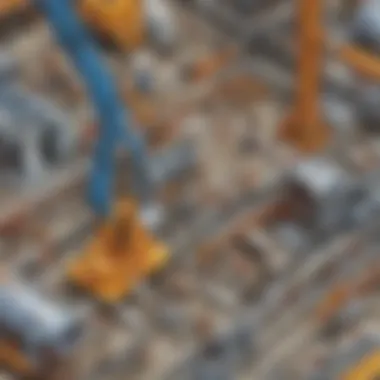Engineering Design and Its Transformative Role in Building


Intro
The world of engineering design in building processes is a fascinating and intricate web of creativity, science, and precision. From ancient architectural marvels like the pyramids to modern skyscrapers that touch the sky, each creation represents the culmination of bold ideas and advanced techniques. As we venture deeper into this topic, we will uncover how these elements coalesce and the future trends shaping our landscapes.
Science Fun Facts
Did you know that the Burj Khalifa in Dubai is the tallest building in the world, reaching a staggering height of 828 meters? Not only does it scrape the sky, but it also showcases what engineering can accomplish when innovative design meets cutting-edge technology. Here are a few more intriguing tidbits about engineering in building:
- Old Meets New: The Great Wall of China, built over centuries, spans about 13,171 miles. It’s a fine example of engineering endurance and adaptability.
- Earthquake-Resistant Buildings: Modern structures use fascinating designs like base isolators and dampers. These innovations allow buildings to sway gently during earthquakes, which can save lives and properties.
- The First Skyscraper: The Home Insurance Building in Chicago, completed in 1885, is considered the first skyscraper. Its steel frame technology opened the floodgates for tall buildings across the globe.
"The only way to do great work is to love what you do." – Steve Jobs
Discover the Wonders of Engineering Design
When it comes to engineering design, there are countless concepts to explore. For instance, the design process often follows several stages: problem identification, brainstorming, design development, prototype creation, and evaluation. These stages aren’t just arbitrary steps—they represent a structured way to ensure that ideas are feasible and innovative. Here we discuss some relevant applications:
- Sustainability: Reflecting on the pressing environmental challenges, engineers are now integrating sustainable materials and practices into their building designs.
- Smart Technology: The infusion of technology, such as smart sensors and AI-driven design tools, enable projects to become more interactive and user-friendly. Examples include energy-efficient buildings that can adjust their temperature based on occupancy.
Thought-Provoking Questions
As we delve into this field, it’s valuable to ponder:
- How can we strike a balance between aesthetic appeal and structural integrity in modern architecture?
- What role does collaboration across disciplines play in effective engineering?
- In what ways can future developments in technology redefine our approach to building design?
By considering these questions, one can appreciate the layered complexity involved in the engineering and building nexus.
Understanding Engineering Design
Engineering design stands as a foundational element in the realm of building and construction. This intricate process encompasses various activities ranging from problem identification to innovative solution formulation. For anyone venturing into engineering, grasping the significance of this discipline is not just valuable, it's essential. As projects increase in scale and complexity, understanding engineering design becomes paramount to ensure both aesthetic appeal and structural integrity.
Definition and Importance
Engineering design can be defined as a structured approach to develop solutions that meet specified requirements. This isn't just about creating something that looks good on paper; it's about functionality and efficiency. Each element needs to be meticulously planned to ensure durability while meeting the client's needs and architectural vision.
The importance of engineering design cannot be overstated. It serves several critical functions:
- Problem-Solving: Identifying and addressing specific challenges is the crux of effective design.
- Budget Management: A well-thought-out design can also minimize costs and save resources down the line.
- Safety: Ensuring that structures can withstand various stressors is vital for public safety.
Architecture and engineering go hand in hand—understanding how these two interact is crucial in today’s building projects. When engineered correctly, the end product is not just a building but a functional space that complements its environment.
Key Principles of Design
When embarking on a design journey in engineering, several principles guide the process. These principles ensure that the final product aligns with both user needs and technical standards. The most notable include:
- Simplicity: A design should be as simple as possible without sacrificing functionality. Overcomplex designs often lead to problems down the road.
- Sustainability: Today, there's a pressing need for designs that not only serve their purpose but also respect the environment. Using sustainable materials and practices can significantly reduce ecological footprints.
- Integrity: The overall stability of the structure should never be compromised in favor of aesthetics. Math and science are not just subjects; they are the building blocks of sound engineering.
By adhering to these key principles, engineering professionals can navigate the balance between creativity and functionality, ensuring balanced and effective designs.
The Role of Creativity in Engineering
Creativity in engineering design is often misunderstood. It's not simply about coming up with artistic expressions; it’s about finding unconventional solutions to complex problems. A successful engineer must engage both analytical skills and creative thinking.
Incorporating creativity into engineering yields numerous benefits:
- Innovation: Original ideas often lead to breakthroughs in building practices and materials.
- Flexibility: A creative mind can adapt designs in response to unforeseen challenges in project development.
- Improved User Experience: Understanding user needs and expectations can lead engineers to develop spaces that enhance quality of life.
For instance, think about how modern buildings often incorporate nature into their designs. This isn't merely an aesthetic decision; it can affect the psychological well-being of occupants.
"The most successful engineers are often those who dare to think outside the box, merging creativity with technical expertise."
In essence, creativity isn’t just welcome; it's vital for the evolution of engineering design. Embracing this blend of skills can pave the way for innovative solutions that transform ideas into tangible realities.
The Stages of Building Development
The stages of building development form the backbone of any successful construction project, guiding it from initial conception to final execution and beyond. Understanding these stages is essential as they ensure that all aspects of a building project are thoughtfully planned and executed. This not only improves efficiency but also significantly reduces the potential for costly mistakes and delays.
Planning and Conceptualization


The planning and conceptualization phase is where ideas begin to blossom. Here, architects, engineers, and clients come together to flesh out an initial concept of what the building will look like, its purpose, and how it will integrate into its environment. This stage isn't just about sketching ideas; it's about aligning goals and expectations.
A few key elements to consider in this phase include:
- Feasibility Studies: These determine whether the project is realistic given financial, environmental, and regulatory constraints.
- Community Impact: Understanding how the proposed building will affect the surrounding area is vital. Will it bring in more traffic? How will it change the neighborhood's character?
- Stakeholder Engagement: Involving all parties affected by the project helps in gaining insights and fosters a sense of ownership.
Taking the time to plan thoroughly can yield benefits that ripple through the entire project. It’s like laying a solid foundation — every layer added later will only stand stronger.
Design Development
Once the conceptual phase concludes, it’s time to dive into design development. This is where the initial thoughts evolve into detailed drawings, models, and specifications. Architects work with engineers to create plans that not only look good on paper but are also structurally sound and functional.
Important considerations during this phase include:
- Technical Drawings: These are essential to communicate precise plans to builders and constructors. They make sure everyone is on the same page.
- Regulatory Compliance: Adhering to local building codes and regulations will save a world of trouble. This often involves submitting designs for approval.
- Material Selection: Choosing the right materials impacts both the building’s durability and its aesthetic appeal. It’s crucial to think about availability and sustainability.
This phase can feel a bit like piecing together a puzzle. One wrong piece can throw the whole picture off, but when it comes together, it’s a sight to behold.
Construction and Implementation
The final piece of the puzzle is the construction and implementation stage, where plans are translated into tangible structures. This phase requires meticulous coordination among different tradespeople to ensure everything aligns as intended. Coordination is key — miscommunication can lead to expensive rework and delays.
Here’s what’s typically involved in this stage:
- Site Preparation: This involves clearing the site, excavation, and laying down a strong foundation — it’s literally the bedrock upon which everything will stand.
- Project Management: Keeping everything on track requires solid leadership. Project managers oversee timelines, budgets, and workforce allocation.
- Quality Control: It's crucial to monitor quality throughout the construction process. Regular inspections and checks help ensure that the project adheres to the design specifications.
The construction phase transforms the abstract designs into real, functional buildings. It’s not just about hammering nails and pouring concrete; it’s about creating spaces where memories will be made.
"Effective building development isn't a race; it's a carefully choreographed dance where timing, precision, and trust intertwine."
By carefully managing each of these stages, the entire construction process can flow smoothly, leading to high-quality buildings that meet the needs of the users. Understanding these stages helps everyone involved appreciate the complexities of building development, from the architect's visionary sketches right down to the final touches on a newly constructed home.
Innovative Technologies in Engineering Design
In today’s fast-paced world, the importance of innovative technologies in engineering design can’t be overstated. These technologies not only streamline processes but also enhance creativity and collaboration within the field of building design. They serve as catalysts for efficiency, sustainability, and adaptability, allowing professionals to tackle complex challenges with confidence and precision. As we delve into this topic, we will uncover the significance of several groundbreaking innovations that are reshaping the landscape of construction and engineering design.
Building Information Modeling (BIM)
Building Information Modeling, or BIM, is a game-changing technology that revolutionizes how buildings are designed and built. This process involves creating a digital representation of the physical and functional characteristics of a structure. It allows all stakeholders—architects, engineers, contractors, and clients—to collaborate more effectively.
Imagine a giant puzzle where every piece fits perfectly; that’s what BIM does for building projects. It integrates various data, from architectural designs to construction schedules, into a single model. This not only saves time and reduces errors but also provides a clearer picture of the project’s progress. Using BIM, teams can anticipate potential issues, share insights, and verify compliance with safety regulations, which in turn leads to cost savings and enhanced project outcomes.
"BIM is like having a detailed blueprint on your computer that everyone can see and work on simultaneously."
3D Printing in Construction
3D printing, often referred to as additive manufacturing, is making waves in construction. This technology allows builders to create structures layer by layer, using materials like concrete or plastic. The impacts of 3D printing are profound, opening doors to customization, cost efficiency, and reducing waste.
With 3D printing, architects can design unique structures that are tailored to the needs of the client, something traditional methods struggle to achieve. For instance, a small school project might require a unique space for various activities—3D printing could easily provide that tailored solution without exceeding budgets. Furthermore, the ability to quickly prototype components means that teams can test and iterate designs faster than ever.
Sustainable Materials and Practices
As the world becomes more environmentally conscious, the use of sustainable materials and practices has emerged as a critical focus within engineering design. This shift isn’t just about using eco-friendly materials; it’s a holistic approach that encompasses every aspect of construction, from sourcing materials to energy efficiency. Using recycled, reclaimed, or rapidly renewable resources can drastically reduce the carbon footprint of a building project.
Additionally, practices such as using energy-efficient systems, integrating green roofs, and implementing smart technologies contribute significantly to sustainability goals. These not only benefit the environment but also result in long-term savings on energy costs, making buildings more economical in the long run.
By prioritizing innovative technologies, the engineering design field is positioning itself for a better, more sustainable future. As these tools continue to advance, we can expect even more revolutionary changes in how we conceive, design, and build our world.
Sustainability in Engineering Design and Building
Sustainability has transforme dramatically how we design and construct buildings. The interplay between human needs and the environment shapes not only the buildings we erect but also the impact they have on our planet. Recognizing this lcture is crucial for anyone involved in the field. Sustainable engineering practices aim to reduce the ecological footprint while still providing comfortable and functional spaces for users. When we incorporate sustainable methods into engineering design, we focus on longevity, resource efficiency, and minimal waste—not just for today, but for future generations as well.
Environmental Considerations
When designing a building, environmental considerations are front and center. This means thinking about the surrounding ecosystem and how it can be preserved or not damaged.
- Natural Resources: Taking into account how materials are sourced is vital. Using locally-sourced materials minimizes transportation, reducing greenhouse gas emissions.
- Energy Efficiency: If a building uses less energy, it creates less pollution. Designs that allow for natural lighting and effective insulation can significantly decrease energy consumption.
- Waste Management: Incorporating plans for recycling and responsible waste disposal during the construction phase can lessen impacts on landfills. Designing for deconstruction rather than demolition also supports this.
"The end game of sustainable design isn’t just about the building itself, but about finding ways to harmonize with the environment around it."


The Lifecycle Assessment Approach
The Lifecycle Assessment (LCA) approach fosters a comprehensive understanding of a building's impact over its entire lifespan. From the extraction of resources to construction, operation, and eventual demolition or recycling, analyzing each phase informs better decision-making.
Key components of LCA include:
- Raw Material Extraction: Assessing the ecological consequences of mining or harvesting materials.
- Manufacturing Process: Understanding energy and emissions involved during the construction of the building materials.
- Operational Usage: Evaluating the energy consumption and waste produced over the life of the building to suggest improvements.
- End-of-life Scenarios: Planning for what happens when a building reaches its end. Can the materials be salvaged? Can the structure be reused in some capacity?
This approach aids in making data-driven decisions that align with sustainable practices.
Green Building Certifications
Green building certifications serve as benchmarks that help both builders and clients understand the sustainable performance of a building. Various organizations offer certifications based on specific criteria and compliance standards.
Some commonly known certifications include:
- LEED (Leadership in Energy and Environmental Design): Provides a point system for various sustainable practices—from water efficiency to sustainable site development.
- BREEAM (Building Research Establishment Environmental Assessment Method): Focuses on the environmental performance of buildings throughout their lifecycle.
- WELL Building Standard: Emphasizes health and well-being of the inhabitants.
Pursuing these certifications not only showcases a commitment to sustainability but may also lead to cost benefits in long run through energy savings and tax incentives.
The Interdisciplinary Nature of Building Projects
In the realm of engineering and architecture, the saying "many hands make light work" rings particularly true. The interdisciplinary nature of building projects emphasizes that collaboration among various fields is essential to the success of any construction endeavor. Fostering teamwork among diverse professionals leads to innovative solutions and alleviates potential pitfalls that may arise during the building process. This approach not only broadens the perspective of the project but also encourages a more thorough examination of the various challenges engineers and architects might face.
Collaborative Design Processes
It is no secret that the collaborative design processes are at the heart of effective building project management. When architects, engineers, contractors, and other stakeholders work together, each party brings their expertise to the table. For instance, during the planning phase, an architect may sketch out an initial blueprint, but it is the involvement of structural engineers who ensure that the design is safe and feasible.
The use of collaborative platforms, such as Building Information Modeling (BIM), allows all parties to visualize and assess the design in real-time. This methodology provides a chance to identify potential issues before construction begins.
Here are some benefits of collaborative design processes:
- Improved communication: Frequent interactions foster a culture of open dialogue, which mitigates misunderstandings.
- Holistic solutions: With input from various disciplines, solutions become well-rounded and address multiple concerns.
- Time efficiency: Identifying problems early on reduces the likelihood of costly delays.
Roles of Various Professionals
In any building project, the roles of various professionals interlink in fascinating ways. While the architect often takes the lead in presenting the overall vision of the building, engineers, constructors, and contractors play crucial roles in bringing that vision to reality.
- Architects: They are the creators of the design. They conceptualize ideas around aesthetics, functionality, and harmony within surroundings.
- Civil Engineers: Their job is to ensure the building’s safety and integrity. They examine loads and stresses that the structure will endure.
- Mechanical and Electrical Engineers: These specialists integrate technology like heating, ventilation, and electricity into designs.
- Construction Managers: They oversee the daily operations and maintain the schedule, ensuring that everything stays on track.
As each professional contributes their unique skills, it becomes evident that the project cannot thrive without their collective input and seamless coordination.
Integrating Feedback Loops
One critical aspect that can enhance the success of interdisciplinary projects is the importance of integrating feedback loops. This practice encourages ongoing communication throughout each project phase. Regular touchpoints allow teams to share insights, ask questions, and propose adjustments based on real-time observations.
For example, if construction workers encounter unexpected site conditions, their feedback can help adjust the design or timelines accordingly. Such adaptability means that projects are less likely to veer off course, thereby saving both time and resources.
Feedback loops can take many forms:
- Regular meetings: These help in discussing project progress.
- Surveys from team members about barriers they face.
- Digital platforms to share updates quickly and efficiently to all stakeholders.
Integrating such feedback mechanisms ensures that every voice is heard, and corrections can be made swiftly, ultimately enhancing the project outcome.
Challenges in Engineering Design and Building
Engineering design and building encompass an array of intricate processes and challenges. Navigating these challenges is crucial for achieving successful outcomes. By addressing issues like budget constraints, regulatory compliance, and technological limitations, practitioners can fine-tune their approaches. These challenges not only impact project timelines but also the overall quality and sustainability of building efforts. Ignoring them could lead to setbacks that ripple across the project life cycle, potentially causing financial strain and dissatisfaction with the end product.
Budget Constraints and Project Delays
Budget constraints play a leading role in engineering design and building projects. When funds are tight, corners may get cut, which can lead to poor quality materials or insufficient safety measures. It's like trying to bake a cake with half the ingredients—while it might come out somewhat okay, the end product is unlikely to satisfy anyone’s palate completely.
Project delays often accompany budget issues. When financial hurdles arise, timelines can stretch longer than any rubber band. This can lead to increased costs as workers sit idly or project teams scramble to rework plans. It’s a tough nut to crack; balancing quality with cost effectively is the name of the game.
People involved must communicate openly. Regular meetings can help keep track on spending and timelines. Creating a detailed budget with contingencies can serve as a safety net, allowing project managers to mitigate risks and navigate unexpected sawtooth financial patterns.
Regulatory and Compliance Issues
Regulatory issues are like the rules at a card game: if you don’t follow them, you'd better expect some pushback. Every building project has to adhere to a variety of local, state, and even federal regulations. These rules are put in place to ensure safety, environmental protection, and community standards. Ignoring regulations can lead to fines, rework, or even shutdowns, which can sink a project faster than a stone in water.


Regulatory changes can sometimes happen unexpectedly. One minute you’re cruising along, and the next you find out that a new guideline mandates your construction techniques be altered. Thus, it’s vital for engineers to stay abreast of changes in legislation and ensure compliance. Collaboration among design teams can help in identifying regulatory needs early in the process, therefore reducing the risk of complications as the project unfolds.
Technological Limitations
Technology is a double-edged sword in the world of engineering design and building. On one hand, it offers innovative tools that can streamline processes; on the other, limitations exist. Not every team has access to the latest software or advanced machinery, which can put some projects at a disadvantage. Think of it this way—if one team is using a high-tech calculator for complex equations while another depends on a basic one, the first team is likely to outperform the second in speed and efficiency.
Furthermore, training must accompany the adoption of new technologies. A team may invest in state-of-the-art equipment, but if the workers lack the know-how, it’s all for naught.
"Utilizing the right technology can push project boundaries, but understanding its limits is equally crucial in avoiding tangled webs of failure."
To tackle these challenges, projects should invest in regular training and infrastructure improvements. An awareness of technological limits allows for better planning. Project teams should also practice flexibility, allowing them to adapt as technology evolves.
Future Trends in Engineering Design and Building
As we stand on the brink of a new era in construction and design, it’s clear that the landscape of engineering is shifting. Future trends in engineering design and building not only represent the possibilities of innovation, but also underscore the critical relationship between technology and sustainability. Understanding these trends is imperative for anyone invested in the building process, from engineers to architects to project managers. Additionally, these trends carry a wealth of benefits—improved efficiency, enhanced safety, and optimized resource use, to name a few.
Smart Buildings and IoT Integration
The rise of smart buildings is one of the most exciting developments in engineering design today. With the integration of the Internet of Things (IoT), buildings are becoming more than just static structures; they are evolving into dynamic environments capable of responding to the needs of their occupants in real-time.
Imagine a school where the lights adjust automatically based on the amount of natural light entering the classrooms, or where heating and cooling systems learn to regulate temperatures based on occupancy patterns. These systems not only enhance comfort but also conserve energy, reducing overall operational costs.
"Smart buildings will change the way we interact with our environment. It's about creating living spaces that adapt to us, rather than the other way around."
To implement smart technologies effectively, design teams must consider the following:
- Connectivity: Ensuring devices and systems can communicate seamlessly.
- User Experience: Creating intuitive interfaces for building occupants to control their environment.
- Data Management: Utilizing analytics to improve building performance over time.
Emerging Material Technologies
Innovations in material science are also paving the way for future engineering design breakthroughs. New materials are being developed that offer greater strength, reduced weight, and enhanced environmental performance. Lightweight composites, for instance, are transforming the construction of bridges, enabling spans that were once thought impossible.
Additionally, materials like self-healing concrete promise to extend the lifespan of structures significantly by autonomously repairing cracks, which may reduce the need for extensive maintenance and prolong the overall durability of buildings. Here are some key considerations:
- Sustainability: Materials must not only perform well but also have minimal environmental impact during their lifecycle.
- Cost-effectiveness: The affordability of these new materials will determine their widespread adoption.
- Performance: Assessing how these materials hold up under various conditions is crucial for safety and longevity.
Adapting to Climate Change
As climate change becomes an increasingly pressing issue, the engineering design field must proactively adapt. This includes not only designing buildings that can withstand extreme weather but also creating structures that contribute positively to the environment. Engineers are now tasked with assessing risks and modifying designs to enhance resilience.
Buildings should be designed to:
- Withstand Natural Disasters: Implementing features that can handle floods, hurricanes, or earthquakes.
- Promote Energy Efficiency: Utilizing renewable energy sources such as solar panels or wind turbines can minimize a building's carbon footprint.
- Enhance Biodiversity: Incorporating green roofs and natural habitats within urban settings can help restore ecological balance.
By embracing these trends and considerations, the future of engineering design will not only solve current challenges but may also create a built environment that is more adaptive, resource-efficient, and sustainable.
Finale: The Future of Engineering Design in Building
The convergence of engineering design and building processes holds significant promise for the future. As we look ahead, it's clear that advancements in technology, along with a commitment to sustainability, are set to transform the landscape of construction. This section will delve into various facets of engineering design's evolution, where lifelong learning, innovation, and the encouragement of young minds will play pivotal roles.
Emphasis on Lifelong Learning
Lifelong learning is a cornerstone in the evolving field of engineering design. Professionals in the industry must keep their skills current due to the rapid advancements in technology and methodologies. Online courses, workshops, and webinars serve as vital avenues for ongoing education. Continuous education not only helps in understanding new tools and processes, but it also fosters a culture of adaptation. This adaptability is crucial as building requirements and standards change frequently, particularly in response to new environmental regulations or technological innovations.
In addition to formal learning, mentorship scenarios can greatly enhance knowledge transfer. New engineers can learn from seasoned professionals, gaining insights that can't be found in textbooks. This kind of knowledge sharing enhances the collective skill set of the industry and ultimately leads to better project outcomes.
The Role of Innovation in Shaping Infrastructure
Innovation is the lifeblood of contemporary engineering design. It affects everything from the materials used in construction to the methodologies adopted for project management. With the advent of smart technology, buildings are no longer just structures; they're becoming integrated systems that respond to their environments.
Innovative practices, like using sustainable materials or applying advanced technology such as Building Information Modeling (BIM), help architects and engineers create more efficient, responsive designs.
Consider this: in some urban areas, engineers are repurposing existing buildings rather than tearing them down. This not only preserves the architectural heritage but also reduces waste and promotes sustainability—two highly valued aspects of modern engineering. Moreover, innovations in modular construction allow for quicker assembly and reduced costs, presenting critical advantages in project timelines and budgets.
Encouraging Young Minds in Engineering
Engaging the next generation of engineers is essential for sustaining the industry. Schools and organizations must prioritize STEM education (Science, Technology, Engineering, Mathematics) to spark interest in engineering from a young age. Programs that foster hands-on experiences, such as internships and workshops, can help students see the real-world applications of their learning.
A greater emphasis on diversity is also crucial. Encouraging participation from varied backgrounds not only enriches the engineering community but also opens up new perspectives that lead to innovative solutions. Mentorship from professionals can guide young individuals and help them navigate the complexities of engineering careers.
In this journey, it's vital to recognize achievements in engineering, showcasing success stories that can inspire young minds. Engaging effectively with youths leads to an empowered generation ready to take on the challenges of tomorrow’s engineering landscape.
"Encouraging diversity and fostering interest in engineering among young minds is not just beneficial for individuals; it can lead to real advancements in how we design and build our world."
As we reflect on the future of engineering design, a clear path emerges—one built on continuous learning, rapid innovation, and a commitment to nurturing the next generation.







